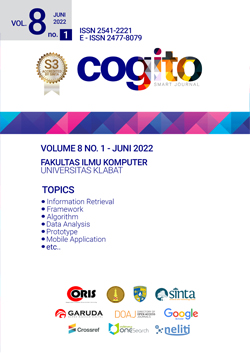Purwarupa Sistem Pemantauan dan Pengendalian Pertumbuhan Tanaman Cabai dalam Screen House
DOI:
https://doi.org/10.31154/cogito.v8i1.338.1-12Abstract
Chili (Capsicum annuum L.) is a well-known spice plant and is loved because of its distinctive spicy taste. In addition, chili also contains good nutrients including vitamins A, B, C, E, potassium, phosphorus, calcium, folate, antioxidants, protein, and anti-cancer substances. Chili cultivation provides good economic potential because market demand is stable and even increases in certain seasons. One of the chili planting methods is by using a screen house which allows farmers to better control various growth parameters. In this study, an IoT-based monitoring and control system for chili plant growth parameters was developed using a Raspberry Pi, sensors, and other electronic devices. Growth parameter data is processed and sent to an online server and then presented with a time series-based visualization.References
Dermawan, R. (2009). Budidaya Cabai unggul. Bogor: Penebar Swadaya.
Sun T. (2007). Antioxidant activities of different colored sweet bell peppers (Capsicum Annum L.). Journal of Food Science 72(2), 98-102.
FAO. (2018). Budidaya Cabai yang baik dan benar. Kementrian Pertanian RI.
Wahyudi A, Topan L. (2011). Panen Cabai di pekarangan rumah. Jakarta: Agro Media Pustaka.
Sumarni. (2005). Budidaya Cabai Merah. Bandung: Balai Penelitian Tanaman.
Yanti F. (2014). Karakter vegetatif dan generatif beberapa varietas Cabai rawit (capsicum frutescens L.) di lahan gambut. Thesis. UIN Suska Riau.
Mercy C. (2005). Design monitoring and evaluation guide book. Portland, USA: Mercy Corps.
Bennet S. (1993). A History of Control Engineering 1930-1955. London, UK: The Institution of Engineering and Technology.
Alddeen YAA, Qureshi KN. (2018). New trends in Internet of things, applications, challenges, and solutions. Telkomnika 16(3), 1114-1119.
Kopetz H. (2011). Real-time systems: design principles for distributed embedded applications. NY, USA: Springer Science & Business Media.
Sekaran K, Meqdad NM. (2020). Smart agriculture management system using internet of things. Telkomnika 18(3), 1275-1284.
Fernando UK, Samarakkody RM. (2020). Connected Vehicles in the Internet of Things: Concepts, Technologies, and Frameworks for the IoT. NY, USA: Springer.
Metcalf D, Milliard STJ, Gomez M, Schwartz M. (2016). Wearables and the Internet of Things for Health: Wearable, Interconnected Devices Promise More Efficient and Comprehensive Health Care. IEEE Pulse 7(5).
Raspberry Pi. Diakses pada Oktober, 27, 2020, dari https://www.raspberrypi.org/help/what-%20is-a-raspberry-pi.
Wiguna EH, Arkhan S. (2017). Rancang bangun sistem monitoring ketinggian air dan kelembaban tanah pada penyiram tanaman otomatis dengan HMI (human machine interface) berbasis Raspberry pi menggunakan software Node-red. Gema teknologi (19:3).
Gunawan R, Andhika T, Sandi, Hibatulloh F. (2019). Sistem Monitoring Kelembapan Tanah, Suhu, pH dan Penyiraman Otomatis Pada Tanaman Tomat Berbasis Internet of Things. Telekontran 7(1).
Yudhaprakosa P, Akbar SR, Maulana R. (2019). Sistem Otomasi dan Monitoring Tanaman Hidroponik Berbasis Real Time OS, Jurnal Pengembangan Teknologi Informasi dan Ilmu Komputer. Jurnal Pengembangan Teknologi Informasi dan Ilmu Komputer 3(4), 3285-3293.
Prayitno, W., Muttaqin, A., & Syauqy, D. (2017). Sistem Monitoring Suhu, Kelembaban, dan Pengendali Penyiraman Tanaman Hidroponik menggunakan Blynk Android. Jurnal Pengembangan Teknologi Informasi dan Ilmu Komputer, vol. 1, no. 4, p. 292-297.
Downloads
Published
How to Cite
Issue
Section
License
Authors who publish with this journal agree to the following terms:- Authors retain copyright and grant the journal right of first publication with the work simultaneously licensed under a Creative Commons Attribution License that allows others to share the work with an acknowledgment of the work's authorship and initial publication in this journal.
- Authors are able to enter into separate, additional contractual arrangements for the non-exclusive distribution of the journal's published version of the work (e.g., post it to an institutional repository or publish it in a book), with an acknowledgment of its initial publication in this journal.
- Authors are permitted and encouraged to post their work online (e.g., in institutional repositories or on their website) prior to and during the submission process, as it can lead to productive exchanges, as well as earlier and greater citation of published work (See The Effect of Open Access).





























